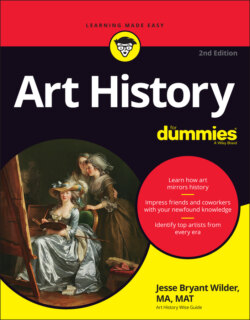Читать книгу Art History For Dummies - Jesse Bryant Wilder - Страница 119
Decoding Books of the Dead
ОглавлениеIn the Old Kingdom, pyramid texts, used to resurrect pharaohs, were inscribed on pyramid walls. They included resurrection spells, charms, passwords, and prayers. During the New Kingdom, similar spells were published in papyrus scrolls called Books of the Dead, which were readily available. Now anyone who could read was resurrectable.
But New Kingdom resurrection came with a hitch. The books weren’t cheap, and you had to be good to be resurrected. Although Books of the Dead were individualized for the owner, they all include a goodness test called the weighing of the heart (see Hu-Nefer’s Book of the Dead in Figure 6-7 — Hu-Nefer was a royal scribe who lived during the 19th dynasty).
The Weighing of the Heart against Maat's Feather of Truth, from the Book of the Dead of the Royal Scribe Hunefer, New Kingdom, c.1275 BC (papyrus)/Egyptian 19th Dynasty (c.1292-1187 BC)/British Museum, London, UK/Bridgeman Images
FIGURE 6-7: This narrative scene from the Book of the Dead illustrates the weighing-of-the-heart ritual, the Egyptian version of the Last Judgment.
The visual narrative in Hu-Nefer’s Book of the Dead shows the rigorous journey through the goodness test to resurrection:
The first test: Anubis, the jackal-headed god of the underworld, leads Hu-Nefer’s ka (soul) to the judgment scales. In his right hand, Anubis holds an ankh, the symbol of life. Things look hopeful for Hu-Nefer. At the scales, Anubis shows up again, this time to weigh the heart, which is contained in a jar on the left scale. The feather of truth (symbol of Maat, the goddess of truth) rests lightly on the right-hand scale. The heart had to be very light not to outweigh a feather!The court reporter, ibis-headed Thoth, records the weight while a monster named Ammit watches greedily. If the heart is heavy, Ammit gets to eat it. But on this occasion, Ammit goes hungry. Hu-Nefer moves on to the next stage.
The second test: The hawk-headed Horus leads Hu-Nefer’s ka to the temple of Osiris to face a second test. To be admitted into paradise, Hu-Nefer must recite secret prayers to Osiris that he memorized while alive — or he could have had the prayers inscribed on his coffin lid if his memory wasn’t up to snuff. Inside Osiris’s temple, Hu-Nefer encounters the four miniature sons of Horus standing on a lotus blossom, a symbol of resurrection.The four sons of Horus are the guys whose heads cap the jars that contain the deceased’s organs. Maat, the goddess of truth, hovers overhead, confirming that Hu-Nefer’s heart is light. Osiris’s wife, Isis, the goddess of life, and sister-in-law Nephthys, goddess of decay, stand behind Osiris.
